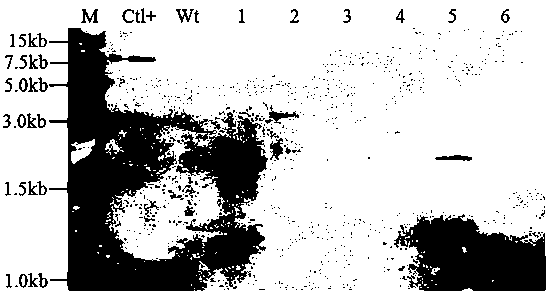A method for cultivating transgenic plants resistant to soybean mosaic virus
A technology of soybean mosaic virus and transgenic plants, which is applied in the field of plant biology and can solve problems that have not been seen
- Summary
- Abstract
- Description
- Claims
- Application Information
AI Technical Summary
Problems solved by technology
Method used
Image
Examples
Embodiment 1
[0030] Example 1. Discovery of Fragments with the Function of Inhibiting Soybean Mosaic Virus
[0031] Sequence alignment of 26 SMV strains registered in GenBank (http: / / www.ncbi.nlm.nih.gov / genbank / ) revealed that the soybean mosaic virus P3 There is a conserved region in the gene, and a 302bp fragment is finally determined in the conserved region, located in P3 The 99th-400th nucleotides from the 5' end of the gene are shown in SEQ-2. The RNA encoded by this fragment is expected to inhibit soybean mosaic virus. The RNA sequence transcribed from the SEQ-2 fragment is the single-stranded RNA shown in SEQ-1.
Embodiment 2
[0032] Example 2. Acquisition and Identification of Transgenic Plants Resistant to Soybean Mosaic Virus
[0033] 1. Construction of RNAi recombinant plasmid
[0034] (1) Synthesize the double-stranded DNA molecule shown in SEQ-2 of the sequence listing.
[0035] (2) Using the double-stranded DNA molecule synthesized in step 1 as a template, using the primer pair composed of SMV-P3-F and SMV-P3-R, perform PCR amplification with KOD FX high-fidelity enzyme (TOYOBO, Japan),
[0036] Obtain the PCR amplification product.
[0037] SMV-P3-F: 5'-CCG CTCGAGTCTAGA TCTCTTGATGGGCTTGGTTTC-3'
[0038] SMV-P3-R: 5'-GG GGTACCAAGCTT GGTTGTTGGATGCTTTTCTTTC-3'
[0039] In SMV-P3-F and SMV-P3-R, the enzyme recognition sequence is underlined, where "CTCGAG" is a restriction enzyme xho Ⅰ enzyme recognition sequence, "TCTAGA" is a restriction endonuclease Xba Ⅰ enzyme recognition sequence, "GGTACC" is a restriction endonuclease Kpn Ⅰ restriction enzyme recognition sequence, " AAGCTT ...
PUM
 Login to View More
Login to View More Abstract
Description
Claims
Application Information
 Login to View More
Login to View More - R&D
- Intellectual Property
- Life Sciences
- Materials
- Tech Scout
- Unparalleled Data Quality
- Higher Quality Content
- 60% Fewer Hallucinations
Browse by: Latest US Patents, China's latest patents, Technical Efficacy Thesaurus, Application Domain, Technology Topic, Popular Technical Reports.
© 2025 PatSnap. All rights reserved.Legal|Privacy policy|Modern Slavery Act Transparency Statement|Sitemap|About US| Contact US: help@patsnap.com



